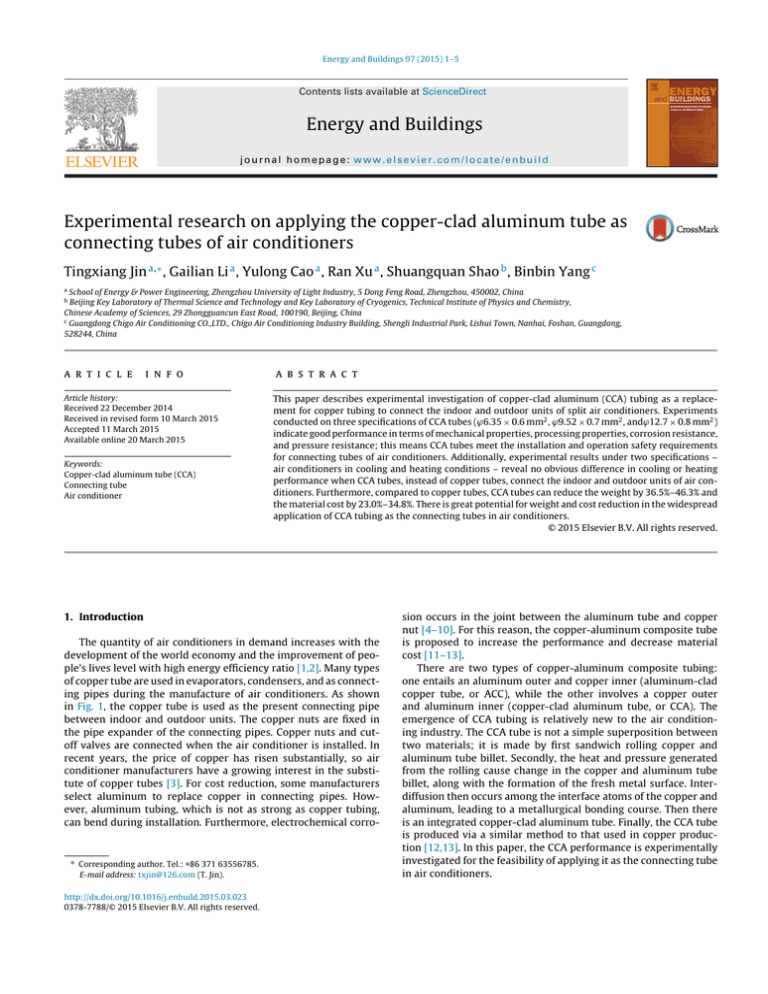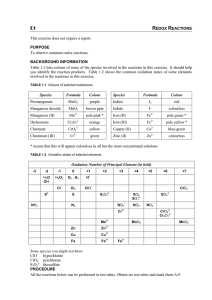
Energy and Buildings 97 (2015) 1–5
Contents lists available at ScienceDirect
Energy and Buildings
journal homepage: www.elsevier.com/locate/enbuild
Experimental research on applying the copper-clad aluminum tube as
connecting tubes of air conditioners
Tingxiang Jin a,∗ , Gailian Li a , Yulong Cao a , Ran Xu a , Shuangquan Shao b , Binbin Yang c
a
School of Energy & Power Engineering, Zhengzhou University of Light Industry, 5 Dong Feng Road, Zhengzhou, 450002, China
Beijing Key Laboratory of Thermal Science and Technology and Key Laboratory of Cryogenics, Technical Institute of Physics and Chemistry,
Chinese Academy of Sciences, 29 Zhongguancun East Road, 100190, Beijing, China
c
Guangdong Chigo Air Conditioning CO.,LTD., Chigo Air Conditioning Industry Building, Shengli Industrial Park, Lishui Town, Nanhai, Foshan, Guangdong,
528244, China
b
a r t i c l e
i n f o
Article history:
Received 22 December 2014
Received in revised form 10 March 2015
Accepted 11 March 2015
Available online 20 March 2015
Keywords:
Copper-clad aluminum tube (CCA)
Connecting tube
Air conditioner
a b s t r a c t
This paper describes experimental investigation of copper-clad aluminum (CCA) tubing as a replacement for copper tubing to connect the indoor and outdoor units of split air conditioners. Experiments
conducted on three specifications of CCA tubes (ϕ6.35 × 0.6 mm2 , ϕ9.52 × 0.7 mm2 , andϕ12.7 × 0.8 mm2 )
indicate good performance in terms of mechanical properties, processing properties, corrosion resistance,
and pressure resistance; this means CCA tubes meet the installation and operation safety requirements
for connecting tubes of air conditioners. Additionally, experimental results under two specifications –
air conditioners in cooling and heating conditions – reveal no obvious difference in cooling or heating
performance when CCA tubes, instead of copper tubes, connect the indoor and outdoor units of air conditioners. Furthermore, compared to copper tubes, CCA tubes can reduce the weight by 36.5%–46.3% and
the material cost by 23.0%–34.8%. There is great potential for weight and cost reduction in the widespread
application of CCA tubing as the connecting tubes in air conditioners.
© 2015 Elsevier B.V. All rights reserved.
1. Introduction
The quantity of air conditioners in demand increases with the
development of the world economy and the improvement of people’s lives level with high energy efficiency ratio [1,2]. Many types
of copper tube are used in evaporators, condensers, and as connecting pipes during the manufacture of air conditioners. As shown
in Fig. 1, the copper tube is used as the present connecting pipe
between indoor and outdoor units. The copper nuts are fixed in
the pipe expander of the connecting pipes. Copper nuts and cutoff valves are connected when the air conditioner is installed. In
recent years, the price of copper has risen substantially, so air
conditioner manufacturers have a growing interest in the substitute of copper tubes [3]. For cost reduction, some manufacturers
select aluminum to replace copper in connecting pipes. However, aluminum tubing, which is not as strong as copper tubing,
can bend during installation. Furthermore, electrochemical corro-
∗ Corresponding author. Tel.: +86 371 63556785.
E-mail address: txjin@126.com (T. Jin).
http://dx.doi.org/10.1016/j.enbuild.2015.03.023
0378-7788/© 2015 Elsevier B.V. All rights reserved.
sion occurs in the joint between the aluminum tube and copper
nut [4–10]. For this reason, the copper-aluminum composite tube
is proposed to increase the performance and decrease material
cost [11–13].
There are two types of copper-aluminum composite tubing:
one entails an aluminum outer and copper inner (aluminum-clad
copper tube, or ACC), while the other involves a copper outer
and aluminum inner (copper-clad aluminum tube, or CCA). The
emergence of CCA tubing is relatively new to the air conditioning industry. The CCA tube is not a simple superposition between
two materials; it is made by first sandwich rolling copper and
aluminum tube billet. Secondly, the heat and pressure generated
from the rolling cause change in the copper and aluminum tube
billet, along with the formation of the fresh metal surface. Interdiffusion then occurs among the interface atoms of the copper and
aluminum, leading to a metallurgical bonding course. Then there
is an integrated copper-clad aluminum tube. Finally, the CCA tube
is produced via a similar method to that used in copper production [12,13]. In this paper, the CCA performance is experimentally
investigated for the feasibility of applying it as the connecting tube
in air conditioners.
2
T. Jin et al. / Energy and Buildings 97 (2015) 1–5
Fig. 2. Schematic plan of bend tester.
Fig. 1. Schematic plan of indoor and outdoor connecting pipe of air conditioner.
40%. In terms of both strength extension and elongation percentages, the three types of CCA tube meet the technical requirement
of connecting tubes.
2. Performance test of CCA tubes
2.1. Technical requirement on connecting tubes of air
conditioners
2.3. Bending performance of CCA tubes
The tested CCA tube consists of outer copper of T2M and inner
aluminum of 3003. The mechanical properties of the copper of T2M
and the aluminum of 3003 are shown in Table 1. The CCA tube is
used to connect indoor and outdoor units when both are fixed to the
wall. In the actual installation of air conditioners, the CCA connecting tube needs a long bending rate. Air conditioner connecting tubes
require good bending rate, good mechanical property, good process
property, good pressure resistance, and good corrosion resistance.
To meet these requirements, air conditioner connecting
tubes with three different diameters–ϕ6.35 mm, ϕ9.52 mm, and
ϕ12.7 mm–are investigated.
2.2. Mechanical property of CCA tubes
Mechanical properties of CCA tubes include strength extension and elongation percentage. With good mechanical property,
the connecting tube bears extension with malleability and avoids
fracturing. The experimental method used is in accordance with
Chinese national standards, GB/T 228-2002 [14]. The experimental
results are shown in Table 2. Compared with the data in Table 1,
the strength extension of CCA tubes falls between 154.3 MPa and
192.4 MPa. The extension strength of CCA tubes is lower than that
of copper tubes and higher than that of aluminum tubes. The three
types of CCA tube tested all have elongation percentages above
Table 1
Mechanical properties of copper tube and aluminum tube.
Type
Material
Strength of
extension (MPa)
Elongation
percentage (%)
Copper
Aluminum
T2M
3003
≥205
95–130
≥40
≤25
Table 2
Mechanical properties of CCA.
Type of CCA (mm2 )
ϕ6.35 × 0.6
ϕ9.52 × 0.7
ϕ12.7 × 0.8
Strength of extension (MPa)
Elongation percentage (%)
≥182.4
≥192.4
≥154.3
≥47
≥42
≥40
The bending performance test is carried out in a bending tester,
which is shown in Fig. 2. The experimental method goes as follows:
one end of the tube being tested is fixed in the grip, and the other
end is bent to 180◦ ; the bending test is repeated eight times. When
the experiment is finished and the bending joint of the CCA tube is
observed, the gash should not appear on the surface. In addition,
there should be no segregation between aluminum and copper on
the cross-section of the bending joint.
The experimental results, presented in Table 3, show that the
gashes do not appear on the surface of the bending joints of any
of the three types of CCA tube. Moreover, the results reveal that
when the experiment is finished, aluminum and copper are not
segregated on the bending joint cross-sections. The experimental
results support that the bending performance of the three types of
CCA tube can meet with the technical requirements of connecting
tube.
2.4. Process property of CCA tubes
Connecting tubes involve flares and therefore must have good
flaring performance [12,13], or process. An experiment on the process property of CCA tubes is carried out using manual expanding
apparatus. The experimental method employed is in accordance
with Chinese national standards, GB/T 242-2007 [15]. This experiment involves, first of all, cutting a proper length in each tube on
one side and, secondly, expanding the top with 90◦ punch – the
expansion rate of which is 50% – for the flaring test. The third step
entails checking the expansion of the top; there should be no be
visible cracks. As the results of this experiment, shown in Table 4,
reveal, the flaring rate of CCA tubes is not lower than that of copper
tubes (≥50%), which illustrates that CCA tubing has a high toughness, similar to copper, and that it can be an alternative to meet the
requirements.
In practical application, connecting tubes link indoor and outdoor units with flarings. There are two flaring production processes
in CCA tubes. One directly expands on its side—the result is shown
in Fig. 3. In this flaring, the inside material is aluminum, while the
valve is connected to copper. With long-lasting contact, it will result
in electrochemical corrosion of the metal surface [12,13], which will
affect reliability.
ID
262463
Title
Experimentalresearchonapplyingthecopper-cladaluminumtubeasconnectingtubesofairconditioners
http://fulltext.study/article/262463
http://FullText.Study
Pages
5




